
The 9th Infantry Division is an inactive infantry division of the United States Army. It was formed as the 9th Division during World War I, but never deployed overseas. In later years it was an important unit of the U.S. Army during World War II and the Vietnam War. It was also activated as a peacetime readiness unit from 1947 to 1962 at Fort Dix, New Jersey, and Fort Carson, Colorado, and from 1972 to 1991 as an active-duty infantry division at Fort Lewis, Washington. The division was inactivated in December 1991.
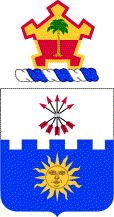
The 22nd Infantry Regiment is a parent regiment of the United States Army. Currently the 2nd Battalion is active, with the regimental colors residing at Fort Drum, New York. The 1st, 3rd, and 4th Battalions have been inactivated.

The 9th Infantry Regiment ("Manchu") is a parent infantry regiment of the United States Army.

The 39th Infantry Regiment is a parent regiment in the United States Army. Originally organized for service in World War I, the 39th fought in most of the conflicts involving the United States during the 20th century, and since 1990 the 2nd Battalion has served as a training unit stationed at Fort Jackson, South Carolina. The 3rd Battalion was started on 21 October 2015 and a 4th Battalion was added in July 2017.
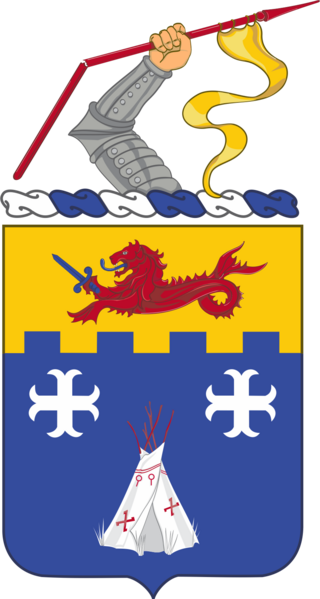
The 12th Infantry Regiment is a unit of the United States Army. The 12th Infantry has fought in seven wars from the Civil War to the Global War on Terrorism and has been awarded 19 Presidential Unit Citations, five Valorous Unit Awards, a Joint Meritorious Unit Award, two citations in the Order of the Day of the Belgian Army, Nine Republic of Vietnam Crosses of Gallantry, the Republic of Vietnam Civil Action Honor Medal Third Class, a Meritorious Unit Commendation, and the Belgian Fourragere.

The 8th Infantry Regiment of the United States, also known as the "Fighting Eagles," is an infantry regiment in the United States Army. The 8th Infantry participated in the Mexican War, American Civil War, Philippine Insurrection, Moro Rebellion, World War I, World War II, Vietnam War, and Iraq Campaign.

The 14th Infantry Regiment is a United States Army light infantry regiment. It has served in the American Civil War, Boxer Rebellion, World War II, Korean War, Vietnam War, Operation Restore Hope, Operation Uphold Democracy, Operation Joint Guard, Operation Desert Storm, Operation Enduring Freedom, Operation Gothic Serpent, Operation New Dawn, Operation Resolute Support,Operation Iraqi Freedom, and Operation Inherent Resolve. The 14th Infantry Regiment did not take part in combat during World War I. It has also conducted peacekeeping and humanitarian missions in the Sinai Peninsula, Guantánamo Bay in Cuba, Bosnia, and Kosovo.

The 1st Infantry Regiment is a regiment of the United States Army that draws its lineage from a line of post American Revolutionary War units and is credited with thirty-nine campaign streamers. The 1st Battalion, 1st Infantry is assigned as support to the United States Military Academy at West Point, New York and to furnish the enlisted garrison for the academy and the Stewart Army Subpost. 2nd Battalion, 1st Infantry Regiment is an infantry component serving with the 2nd Stryker Brigade, 2nd Infantry Division at Joint Base Lewis–McChord, Washington.

The U.S. 60th Infantry Regiment is a regimental unit in the United States Army. Its 2nd and 3rd Battalion conduct Basic Combat Training.
The 54th Infantry Regiment is a United States Army Regimental System parent regiment of the United States Army. It is represented in the active Army by the 2nd and 3rd Battalions, which conduct Infantry One Station Unit Training (OSUT) at Fort Moore, Georgia.
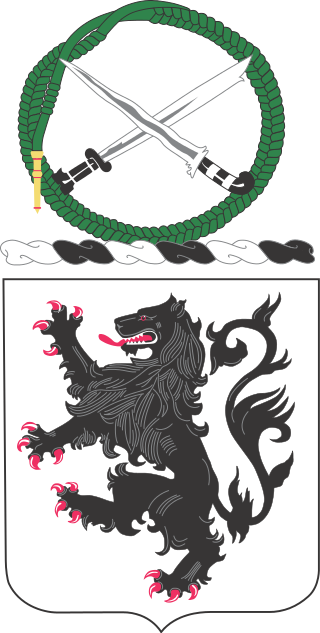
Since the establishment of the United States Army in 1775, three regiments have held the designation 28th Infantry Regiment. The first was a provisional unit that was constituted on 29 January 1813 and served during The War of 1812. The second was a reorganization and redesignation of 2nd Battalion, 19th Infantry Regiment on 1 October 1866 for the American Indian Wars. This incarnation of the 28th Infantry Regiment lasted until 15 March 1869, when it was consolidated back into the 19th Infantry Regiment. The third version of the 28th Infantry Regiment is the one that has the permanent designation and history, and is the one this article is about.

The 2nd Infantry Regiment is an infantry regiment in the United States Army that has served for more than two hundred years. It was constituted on 12 April 1808 as the 6th Infantry and consolidated with 4 other regiments in 1815 to form the present unit.
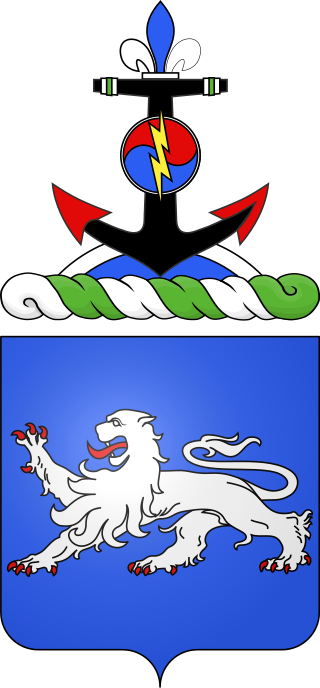
The 68th Armor Regiment is an armored regiment of the United States Army. It was first activated in 1933 in the Regular Army as the 68th Infantry Regiment.

The 17th Infantry Regiment is a United States Army infantry regiment. An earlier regiment designated the 17th Infantry Regiment was organized on 11 January 1812, but it was consolidated with four other regiments as the 3rd Infantry in the post-war reorganization of the army following the War of 1812, due to the shattering losses it sustained at the River Raisin. The current 17th Infantry was constituted as the 17th Regiment of Infantry on 3 May 1861.
The 304th Infantry Regiment currently consists of two battalions in the United States Army Reserve. In the current organizational plan of the U.S. Army, regimental designation is used only in historical tradition; there is no regimental commander, staff or headquarters. The 1st Battalion, 304th Regiment is headquartered in Londonderry, New Hampshire, and the 3rd Battalion, 304th Regiment is headquartered in Saco, Maine.
The 34th Infantry Regiment is a Regular Army infantry regiment of the United States Army. It saw combat in World War I, in the Pacific Theater of Operations in World War II, and was the first full American regiment deployed in combat in the Korean War. The 1st and 3rd Battalions of the 34th are now basic training formations attached to the 165th Infantry Brigade at Fort Jackson, South Carolina.

The 36th Infantry Regiment is a United States Army infantry regiment.

The 48th Infantry Regiment is an infantry regiment in the United States Army first formed in 1917.
The 16th Field Artillery Regiment is a field artillery regiment of the United States Army. The regiment served with the 4th Division in World War II and with the 4th and 8th Divisions between the World Wars. As the 16th Armored Field Artillery Battalion, it served with the 9th Armored Division during World War II, and with the 2nd Armored Division after the war. Designated a parent regiment under the Combat Arms Regimental system, and later the U.S. Army Regimental System, since 1957, regimental elements have served with the 1st, 2nd and 4th Armored Divisions; the 4th, 8th, and 81st Infantry Divisions; and the 1st Cavalry Division. Regimental elements have participated in combat in Vietnam, and in Operation Iraqi Freedom. The regiment currently has a single active battalion, the 3rd Battalion, 16th Field Artillery, assigned to the 2nd Brigade Combat Team, 1st Cavalry Division and stationed at Fort Cavazos, Texas.
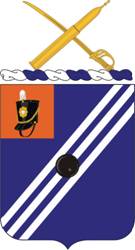
The 76th Field Artillery Regiment is a field artillery regiment of the United States Army. First formed as a cavalry regiment in 1916, the regiment was converted to field artillery in 1917, and served in Europe during World War I with the 3rd Division and as a separate battalion during World War II, as well as in peacetime at Fort Knox, KY, and Fort Devens, MA. Since 1959, the regiment has been a parent regiment under the Combat Arms Regimental System and the U.S. Army Regimental System, with regimental elements serving with the 3rd Infantry Division in Germany and Operation Iraqi Freedom, with the 7th Infantry Division in Korea, and in the Army Reserve. No regimental elements are currently active.


















